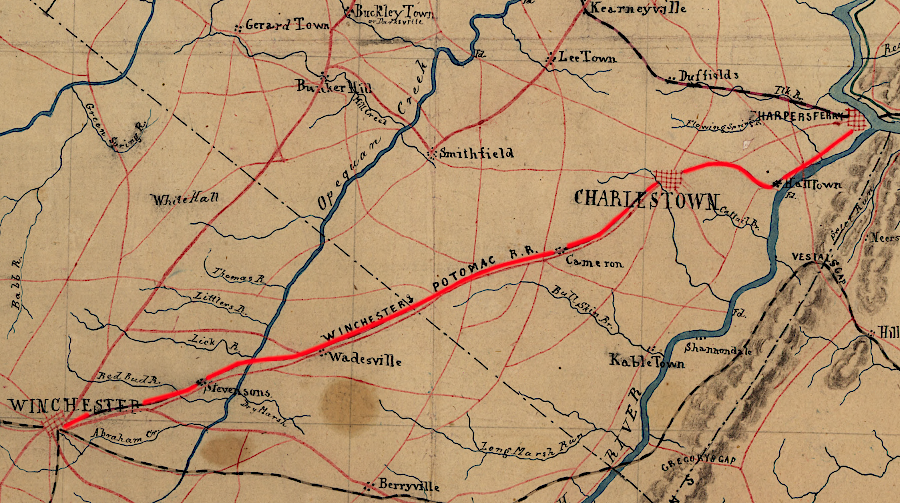
the Winchester and Potomac Railroad started operating in 1836
Source: Library of Congress, Part of map of portions of the milit'y dep'ts of Washington, Pennsylvania, Annapolis, and north eastern Virginia (1861)

the Winchester and Potomac Railroad started operating in 1836
Source: Library of Congress, Part of map of portions of the milit'y dep'ts of Washington, Pennsylvania, Annapolis, and north eastern Virginia (1861)
Baltimore's business leaders announced in 1827 that they would build a railroad to the Ohio River. Within months, the equivalent leaders in Winchester requested that their town be included on the route of the Baltimore & Ohio (B&O) railroad. When it was clear that the railroad would to go west from Harpers Ferry through the Potomac River valley rather than south through the Shenandoah Valley, Winchester decided to build its own railroad to connect to the Baltimore & Ohio Railroad at Harpers Ferry.1
James D. Dilts, The Great Road: The Building of the Baltimore and Ohio, the Nation's First Railroad, 1828-1853, Stanford University Press, 1993, p.191, https://www.google.com/books/edition/_/JjrCWPwvHzIC (last checked April 8, 2020)
The Winchester and Potomac Railroad was chartered by the Virginia General Assembly on April 8, 1831. It was in the interests of the wealthy landowners west of the Blue Ridge, especially in Frederick County, to buy stock in the Winchester and Potomac Railroad. Lower transportation costs would make their land more profitable.
The Bureau of Public Works agreed to purchase 20% of the stock. That percentage was increased to 40% in 1833, in order to provide more capital for construction.
Building the 32-mile Winchester and Potomac Railroad would reduce transportation costs from the lower (northern) end of the Shenandoah Valley to markets in the east. The potential for freight traffic was high. Products were being rafted down the Shenandoah River from as far away as Port Republic. Wheat was being carted by wagon down the Great Wagon Road/Valley Turnpike; livestock was being driven in early cattle/horse drives from even further away.
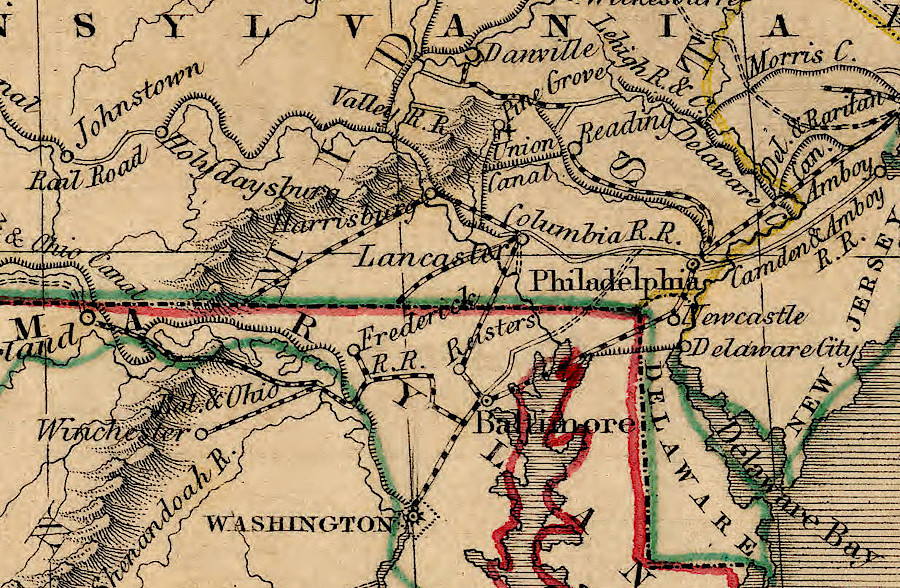
in 1842, Winchester was linked by rail to Baltimore, Washington, Philadelphia, and New York
Source: University of North Carolina, United States, exhibiting the railroad & canals (by Thomas G. Bradford, c.1842)
Three routes for the track were surveyed between Harpers Ferry and Winchester, varying in length from 32-37 miles. The Western Route paralleled the Potomac River upstream to Elks Run, a route ultimately used by the Baltimore and Ohio Railroad.
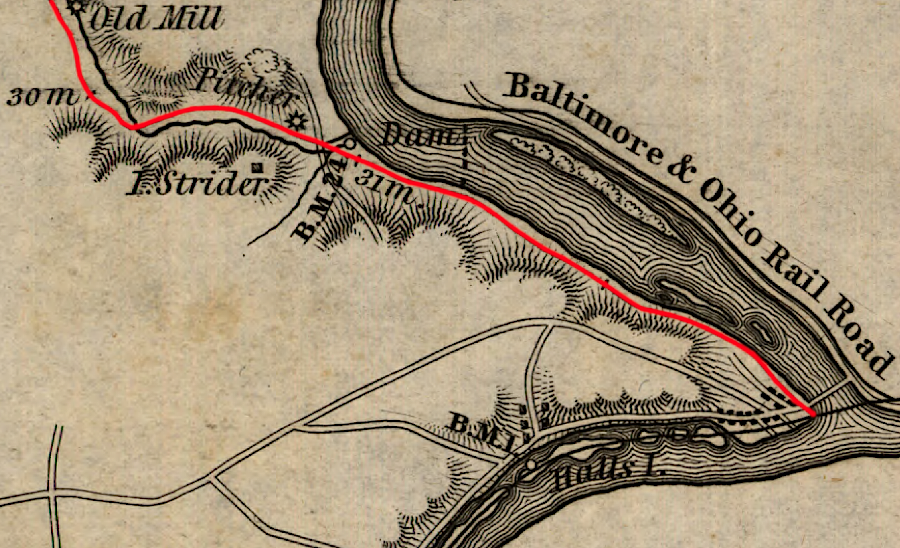
the Western Route (red line) surveyed for the Winchester and Potomac Railroad was ultimately used by the Baltimore and Ohio Railroad
Source: University of North Carolina, Map of the routes examined and surveyed for the Winchester and Potomac Rail Road (by Capt. J. D. Graham, 1831?)
The Eastern Route followed the Shenandoah River upstream from Harpers Ferry to Long Marsh Run, passing north of Berryville to Winchester.
The adopted Charlestown or Middle Route paralleled the Shenandoah River upstream only to Flowing Springs Branch, then through Charles Town to Winchester. Variants of the three major choices were identified, using different stream valleys to minimize grade. The Western Route would have required 190 feet of "Aggregate ascents above the horizontal plane" compared to just 115 feet for the Charlestown/Middle Route which was selected.1
"Map of the routes examined and surveyed for the Winchester and Potomac Rail Road," Capt. J. D. Graham, 1831(?), http://hdl.loc.gov/loc.gmd/g3883f.rr006190 (last checked May 14, 2020)
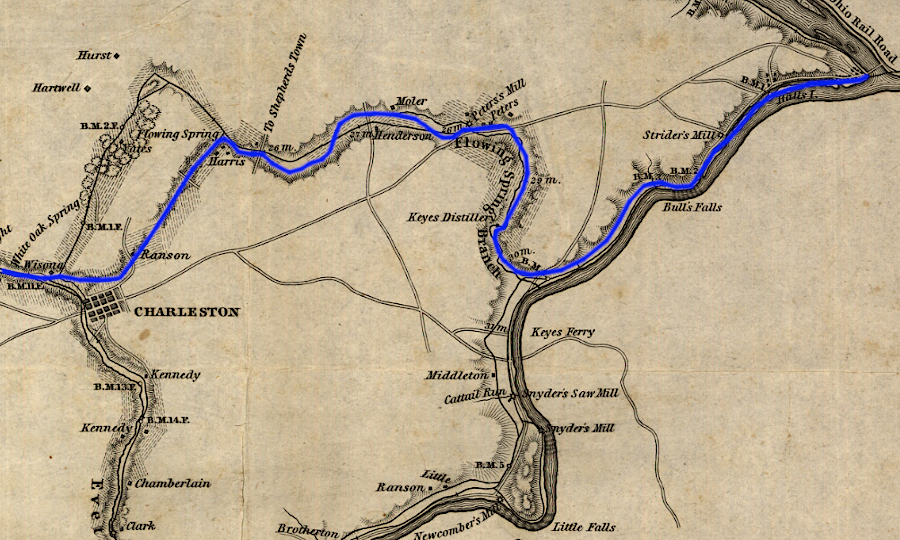
the Charlestown or Middle Route (blue line) chosen by the Winchester and Potomac Railroad minimized elevaton changes
Source: University of North Carolina, Map of the routes examined and surveyed for the Winchester and Potomac Rail Road (by Capt. J. D. Graham, 1831?)
The Baltimore and Ohio (B&O) Railroad and the Chesapeake and Ohio Canal were building westward to the Ohio River. Both planned to pass through the narrow river gap at Harpers Ferry. There the canal and railroad would compete to ship iron, livestock, wheat, and other freight produced in the Shenandoah Valley.
When the Virginia legislature issued the charter for the Winchester and Potomac Railroad, construction had stopped at the similar Point of Rocks chokepoint 13 miles downstream and fighting in court about who owned the land there. The General Assembly's approval of a railroad also came when Alexandria was still a part of the District of Columbia.
In 1831, there were delegates and state senators from districts in Northwestern Virgina who desired cheaper transportation of their region's agricultural products to a port city, where there were more customers so prices were higher. All members of the General Assembly would have preferred transportation of Virginia-grown products through the Potomac River valley to a Virginia port, but the practical choices were limited to Georgetown, Alexandria, Baltimore and Philadelphia. In 1831, all four ports were all outside of Virginia. There were no members in the General Assembly elected from Alexandria, so chartering the Winchester and Potomac Railroad and diverting to Baltimore would not impact rade at any Virginia port.
The Chesapeake and Ohio (C&O) Canal reached Harpers Ferry in 1833. The Baltimore and Ohio (B&O) Railroad got to Sandy Point, across the river from Harpers Ferry, at the end of 1834. The Winchester and Potomac Railroad reached Harpers Ferry in 1836, constructed primarily by 500 Irish laborers. The initial rails were straps of iron on wooden timbers. The track was located close to the Shenandoah River to take advantage of the level topography. That route lowered short-term construction costs, but resulted in higher long-term operational costs as some trestles and track were washed out by occasional floods.
Trains brought "plaster" (gypsum to enhance the growth of crops), coal, salt, fish, and general merchandise to Winchester. Exports from the Valley to Baltimore included iron, manganese, and lead plus the standard agricultural products of flour, produce, and livestock. Until the Virginia and Tennessee Railroad reached Salem in 1852 and the Virginia Central reached Staunton in 1854, much of the trade from west of the Blue Ridge was carted to Winchester for shipment by rail to Baltimore.1
J. Randolph Kean, "The Development of the 'Valley Line' of the Baltimore and Ohio Railroad," The Virginia Magazine of History and Biography, Volume 60, Number 4 (October, 1952), pp.538-542, https://www.jstor.org/stable/4245875 (last checked April 6, 2020)
The engineer responsible for constructing the Winchester and Potomac Railroad, Moncure Robinson, recognized that the toll bridge built across the Potomac River in 1829 for wagons would not be suitable for trains. Benjamin Henry Latrobe Jr., with equivalent responsibility for the Baltimore and Ohio Railroad, concurred. The 90° angle on the Maryland site was too tight; a wider curve was required.
The two railroads cooperated to build a new bridge designed by Latrobe and Lewis Wernwag, who had designed the 1829 bridge. The new bridge included a lane for wagons and pedestrians, and the owner of the toll bridge negotiated a compensation deal for switching non-rail traffic to the new bridge.1
James D. Dilts, The Great Road: The Building of the Baltimore and Ohio, the Nation's First Railroad, 1828-1853, Stanford University Press, 1993, p.191, p.207, https://www.google.com/books/edition/_/JjrCWPwvHzIC (last checked April 8, 2020)
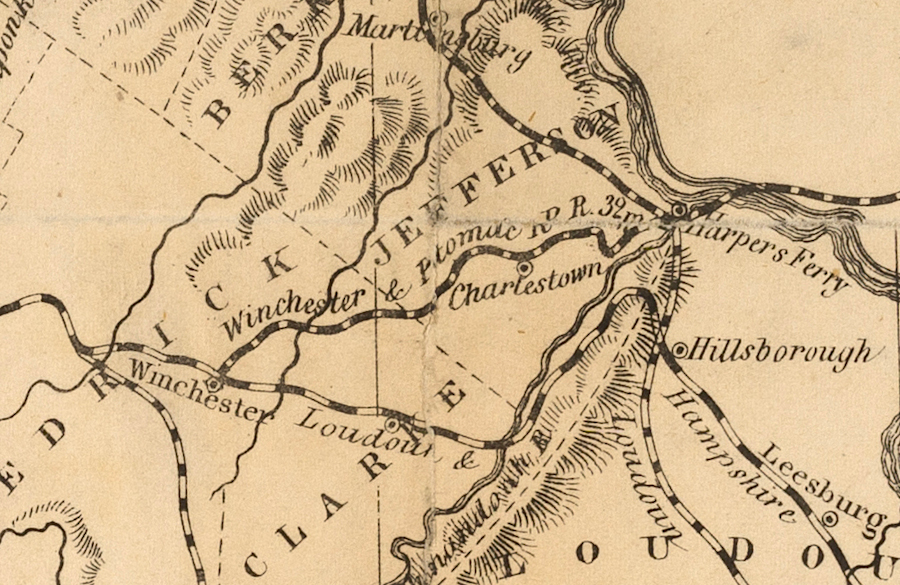
the Winchester and Potomac Railroad brought traffic to Harpers Ferry, connecting there to the Baltimore and Ohio Railroad and the Chesapeake and Ohio Canal
Source: Library of Virginia, A map of the rail roads of Virginia
The Winchester and Potomac Railroad agreed to build the abutment on the Virginia shoreline. The Baltimore and Ohio Railroad committed to construction of the abutment on the Maryland side, plus the six piers across the Potomac River and the bridge's superstructure.
The Baltimore and Ohio Railroad had agreed to cross the Potomac River at Harper's Ferry to resolve the conflict with the Chesapeake and Ohio Canal for the right-of-way at Point of Rocks . West of Harpers Ferry, the canal would be the only transportation system on the Maryland side of the Potomac River.
The railroad bridge over the Potomac River was completed in 1837, including the roof that made it a covered bridge. In 1837, as a financial recession ("panic") developed nationwide, Winchester became the first city in Virginia to get a rail connection to Baltimore, Philadelphia and New York. Shipment of agricultural products from the Shenandoah Valley to Harpers Ferry and points north began 25 years before Alexandria was connected by rail to Baltimore via the Long Bridge in Washington, DC.
The Baltimore and Ohio Railroad started constructing track west from Harpers Ferry in 1839. It had considered using the Winchester and Potomac Railroad and going south, parallel to the Shenandoah River, for six miles before building new track towards Charles Town, Martinsburg and the coal fields at Cumberland. That option required getting rights to use the track owned by the Winchester and Potomac Railroad, but the two railroads could not negotiate a deal.
When the Baltimore and Ohio Railroad was forced to build along the Potomac River to Elks Run at the western edge of Harpers Ferry, the track alignment required a hard right turn to go parallel to the Potomac River. To maintain the link with the Winchester and Potomac Railroad, in 1839 the Baltimore and Ohio had to modify the Virginia side of its 1837 Potomac River bridge to create a Y-shaped ("wye") intersection. The bridge designers had assumed the two railroads would meet in a head-on connection, without a sharp turn in the river.
Construction of two separate freight depots rather than just one building at the wye where they branched is another sign of the independent management of the two railroads. Again the Washington and Potomac Railroad appears to have chosen not to cooperate with the B&O, since an executive of that line had predicted after completion of the Potomac River bridge in 1837 that:1
Frank Griggs Jr., "B&O Railroad Bridge at Harpers Ferry – 1836," Structure Magazine, August 2014, https://www.structuremag.org/?p=4068; Andrew S. Lee, "Historical Background Report - Baltimore and Ohio Railroad, Harpers Ferry Station," Harpers Ferry National Historical Park, National Park Service, 2003, pp.6-8, https://www.nps.gov/parkhistory/online_books/hafe/harpers_ferry_station.pdf (last checked April 6, 2020)
The span of the bridge used by just the Winchester and Potomac Railroad was upgraded in 1851 with an iron truss replacing the wooden superstructure. The 124-foot "Winchester Span" was an innovative design developed by the Baltimore and Ohio Railroad's primary bridge engineer, Wendel Bollman, and the parts were constructed in the railroad's machinery shop in Baltimore. The main track used by the B&O trains going east-west remained underneath a wooden roof, but the Winchester Span was no longer a covered bridge.1
Robert M. Vogel, "The Engineering Contributions of Wendel Bollman," United States National Museum Bulletin 240, Smithsonian Institution, http://www.gutenberg.org/files/33912/33912-h/33912-h.htm (last checked April 7, 2020)
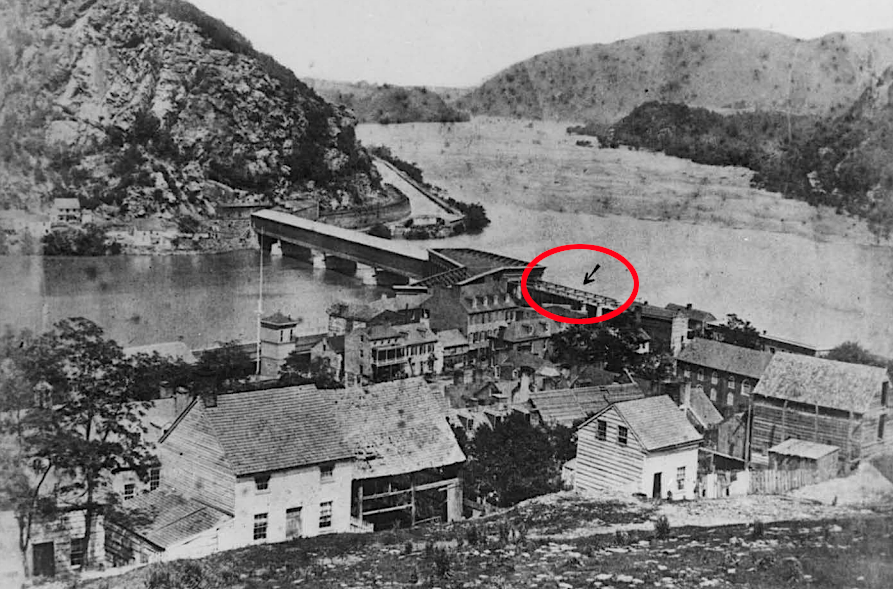
in 1851, iron trusses were installed to create the Winchester Span while the mainline track remained covered with wood
Source: Maryland Historical Trust, B&O Railroad Bridge, Potomac River & Tunnel
The 1837 bridge, with its 1839 and 1851 modifications, was destroyed in the Civil War. It was rebuilt in 1870 using iron trusses placed on the 1837 piers. The 1870 Bollman Iron Truss bridge allowed vehicles and pedestrians, as well as trains, to cross the Potomac River.
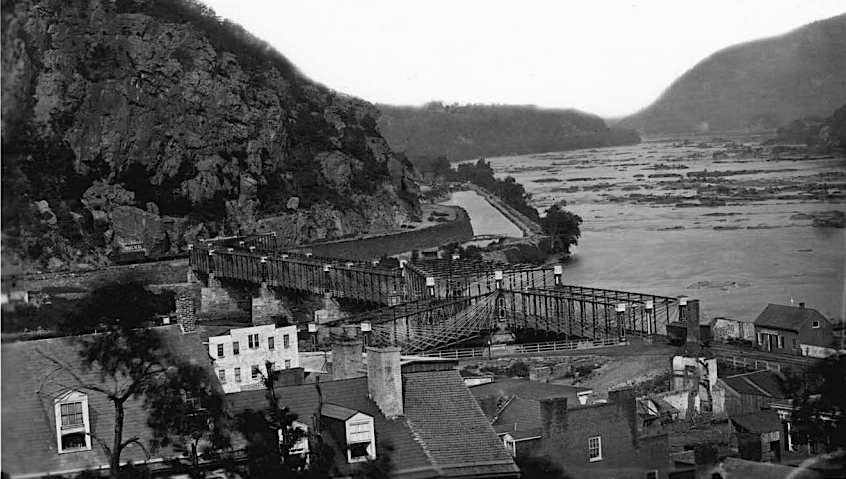
the 1870 iron truss bridge retained the track alignment implemented first in 1839, still requiring B&O trains to make a sharp turn in Harpers Ferry
Source: Maryland Historical Trust, B&O Railroad Bridge, Potomac River & Tunnel
In 1894 a new rail-only bridge was constructed to reduce the sharp curve, an improvement made possible by blasting a tunnel through Maryland Heights. The 1870 bridge was retained for use by carriages and pedestrians. It was destroyeed in a 1936 flood, but the piers are still visible in the river.
The 1894 railroad bridge altered the "wye" configuration for trains to go west to Martinsburg or south to Winchester on the track of the old Winchester and Potomac Railroad, which was then called the Valley Branch of the B&O Railroad:1
Andrew S. Lee, "Historical Background Report - Baltimore and Ohio Railroad, Harpers Ferry Station," Harpers Ferry National Historical Park, National Park Service, 2003, pp.12-14, https://www.nps.gov/parkhistory/online_books/hafe/harpers_ferry_station.pdf; "B & O Railroad Potomac River Crossing," Maryland Historical Trust, February 14, 1978, https://mht.maryland.gov/nr/NRDetail.aspx?NRID=462; "Baltimore and Ohio Railroad Crossing of the Potomac River between Maryland Heights, Maryland and Harpers Ferry, West Virginia," National Register of Historic Places Inventory -- Nomination Form, 1978, https://mht.maryland.gov/secure/medusa/PDF/Washington/WA-III-027.pdf (last checked April 6, 2020)
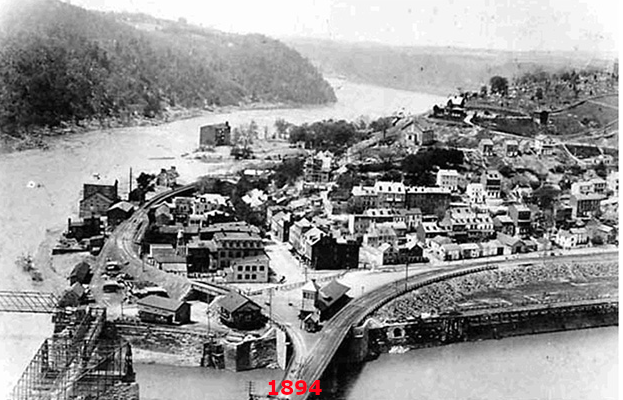
the piers of the 1839/1870 bridges supported a vehicle/pedestrian bridge (on left) after the 1894 bridge was completed, until a 1936 flood left just the piers
Source: National Park Service, United States Armory Grounds and Potomac Riverfront Cultural Landscape
In 1931, the Baltimore and Ohio Railroad completed a new bridge for the mainline of the B&O going west to Martinsburg. The Maryland Heights tunnel was widened to nearly eliminate the curved track. The 1894 bridge was retained, and since 1931 has been used exclusively by trains going to and from Winchester.1
"B & O Railroad Potomac River Crossing," Maryland Historical Trust, February 14, 1978, https://mht.maryland.gov/nr/NRDetail.aspx?NRID=462 (last checked April 6, 2020)
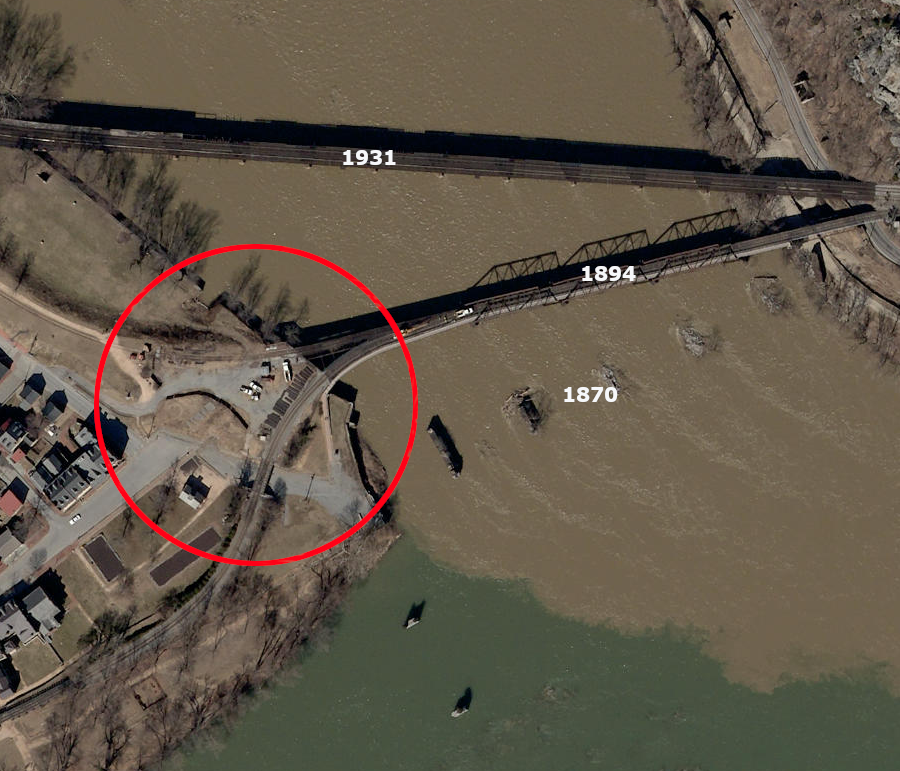
the 1894 bridge, still with a "wye" configuration connecting to Winchester, is upstream of the piers of the 1870 bridge
Source: ESRI, ArcGIS Online
At the start of the Civil War, after 25 years of operations, the track was still wooden stringers topped with a 2.5" wide strip of iron. Trestles across streams and along the Shenandoah River were able to handle the weight of just light locomotives. Trains averaged less than 15 miles/hour on the 32-mile trip between Harpers Ferry and Winchester. The Baltimore and Ohio Railroad had long since replaced its "strap iron" with solid iron "T" rails.1
Edward B. Burns, "The Confederates Gather Steam," The Railway and Locomotive Historical Society Bulletin, Nunmber 104 (April 1961), p.8, https://www.jstor.org/stable/43517986 (last checked April 6, 2020)
The Winchester and Potomac Railroad never had enough capital to be able to afford powerful locomotives or an adequate number of freight cars. The Baltimore and Ohio supported operations in 1841 by allowing the Winchester and Potomac locomotives to haul the B&O's already-loaded freight cars to Winchester, then load them there for the return trip to Baltimore. At most other railroad junctions, freight would be emptied from one railroad's cars and reloaded into cars belonging to the next railroad. That was an inefficient practice, but it ensured that each railroad retained control over its physical assets.
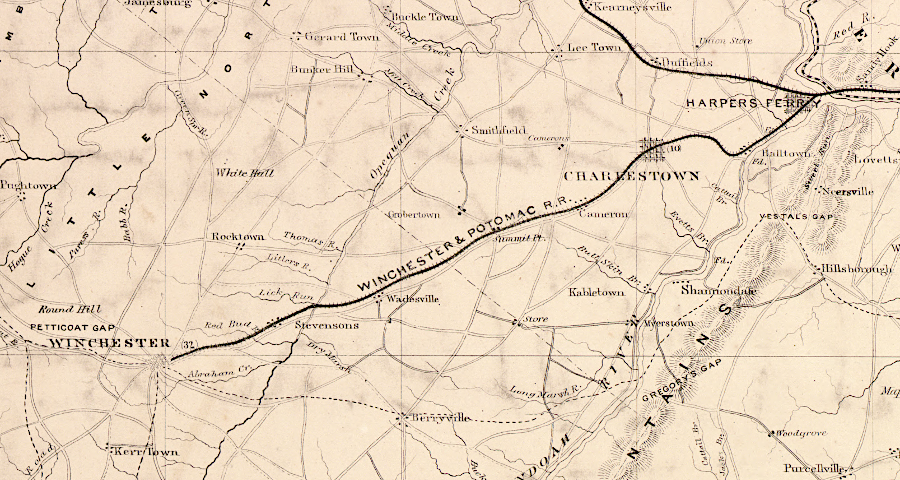
the Winchester and Potomac Railroad connected with just the Baltimore and Ohio Railroad until after the Civil War
Source: Library of Congress, Map of part of Virginia, West Virginia, and Maryland
The Virginia General Assembly passed a law in 1845 allowing the Baltimore and Ohio (B&O) Railroad to purchase the Winchester and Potomac Railroad. The option was not exercised, and in 1847 the Alexandria and Harpers Ferry Railroad obtained a charter to build to Harpers Ferry. It planned to connect with the Winchester and Potomac Railroad. A link with the Alexandria and Harpers Ferry Railroad would divert traffic from the Shenandoah Valley to Alexandria, and reduce the tonnage being hauled from Winchester by the Baltimore and Ohio Railroad to Baltimore.
To prevent the diversion of traffic that had moved onto the Baltimore and Ohio Railroad tracks at Harpers Ferry since 1837, that railroad acquired enough stock in 1848 to gain control over the line to Winchester. The Winchester and Potomac Railroad technically stayed a independent line, but was controlled by the Baltimore and Ohio Railroad. Investors in the Alexandria and Harpers Ferry Railroad lost interest, and Alexandria focused on building the Orange and Alexandria Railroad on the east side of the Blue Ridge.
With the support of the Baltimore and Ohio Railroad, the Winchester and Potomac Railroad could raise new capital in 1849. It sold 20-year bonds through the Corcoran and Riggs bank in Washington, DC. With the extra cash, and with access to equipment and support from the Baltimore and Ohio Railroad for operations, the Winchester and Potomac Railroad paid its first dividend.
Though the feasibility of a railroad line from Alexandria to Harpers Ferry was blocked by the Baltimore and Ohio Railroad in 1848, efforts continued to expand Alexandria's transportation network into the Shenandoah Valley.
The Manassas Gap Railroad got its charter in 1850. After it built track across the Blue Ridge to Strasburg, it built south to Harrisonburg. Had the Manassas Gap Railroad been chartered to build north to Winchester, then agricultural products from more of the valley could get to Winchester. That was not authorized in the charter; a railroad between Strasburg-Winchester would have allowed Baltimore to compete for more Virginia business.
Virginia was slow to develop the transportation infrastructure needed by farmers to get crops to ports, and Baltimore had a railroad monopoly in the Shenandoah Valley for over 15 years. The James River and Kanawha Canal reached Buchanan in 1851, the Virginia Central Railroad reached Staunton in 1854, and the Manassas Gap Railroad started operating to Strasburg in 1854.1
J. Randolph Kean, "The Development of the 'Valley Line' of the Baltimore and Ohio Railroad," The Virginia Magazine of History and Biography, Volume 60, Number 4 (October, 1952), pp.542-545, https://www.jstor.org/stable/4245875; Herbert H. Harwood Jr., Rails to the Blue Ridge: The Washington and Old Dominion Railroad, 1847-1968, Northern Virginia Regional Park Authority, 2000, pp.11-12, https://www.google.com/books/edition/_/2GvQAAAACAAJ (last checked June 4, 2020)
During the Civil War, the Confederates removed as much of the equipment and material of the Baltimore and Ohio Railroad as it could transport to the Manassas Gap Railroad at Strasburg. Four of the lightest B&O railroad engines were driven down the track to Winchester, then hauled by horsepower down the Valley Pike.1
Rail and other supplies were also stripped from the Winchester and Potomac Railroad, as the Confederates realized they would lose control of the area. When the Union Army was planning to occupy the Shenandoah Valley in 1864 in order to prevent shipments of wheat and livestock to Robert E. Lee's Army of Northern Virginia, the track had to be rebuilt.
A more-agressive Union general, Philip Sheridan was given command of the Army of the Shenandoah in August, 1864. The US Military Railroad construction corps removed 33 miles of rails from the Manassas Gap Railroad and relaid them on the crossties of the Winchester and Potomac Railroad between August 14-19, 1864. The railroad transported supplies for six miles between Harpers Ferry and Halltown, in preparation for Sheridan's 1864 Valley Campaign.
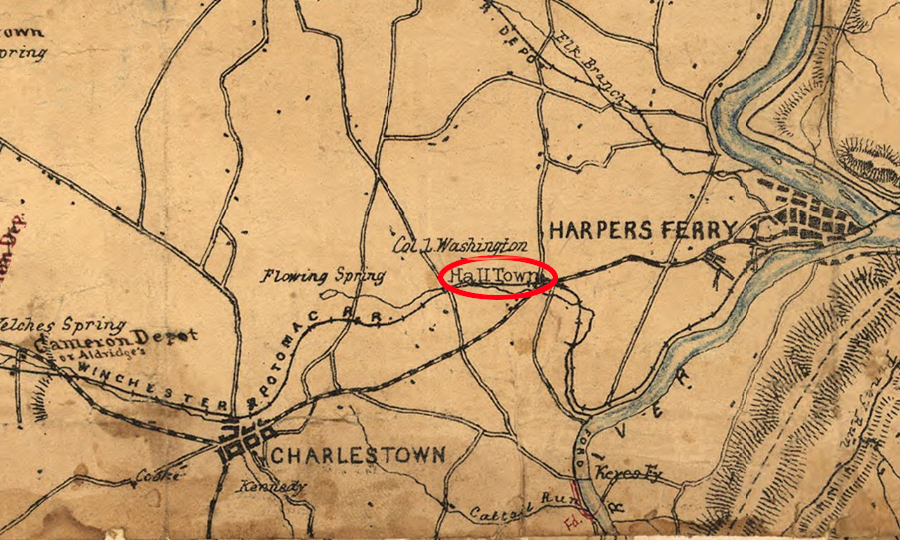
the US Military Railroad operated between Harpers Ferry-Halltown starting in August, 1864
Source: Library of Congress, Upper Potomac from McCoy's Ferry to Conrad's Ferry and adjacent portions of Maryland and Virginia
After General Sheridan's "burning" of the barns and mills in the Shenandoah Valley and then the Battle of Cedar Creek on October 19, the remnants of Confederate General Jubal Early's army retreated south to Staunton. The US Military Railroads placed more rails on the bed of the Winchester and Potomac Railroad between November 2-24, extending it to Stevenson. Trains suppplied the Union forces in the valley until the war ended, and in the first months of Reconstruction.
The United States Military Railroad operated the Winchester and Potomac Railroad until it was returned to the private stockholders in January 1866. Those private owners were rebuilding their own farms and other businesses, and lacked the capital needed to buy locomotives and railroad cars. The stockholders leased their railroad to the Baltimore and Ohio Railroad for 99 years. The B&O had the locomotives and freight cars needed for operations and the resources to maintain the trestles and track. Business was sufficient that by the end of 1866, it had recovered 2/3 of the initial costs for restarting operations.1
Edward B. Burns, "The Confederates Gather Steam," The Railway and Locomotive Historical Society Bulletin, Number 104 (April 1961), p.543, https://www.jstor.org/stable/43517986; J. Randolph Kean, "The Development of the 'Valley Line' of the Baltimore and Ohio Railroad," The Virginia Magazine of History and Biography, Volume 60, Number 4 (October, 1952), pp.544-545, https://www.jstor.org/stable/4245875; Daniel C. McCallum, "United States Military Railroads Report," Government Printing Office, 1866, p.6, p.9, https://openlibrary.org/books/OL24992627M/Reports_of_Bvt._Brig._Gen._D._C._McCallum_Director_and_General_Manager_of_the_Military_Railroads_of_ (last checked April 11, 2020)
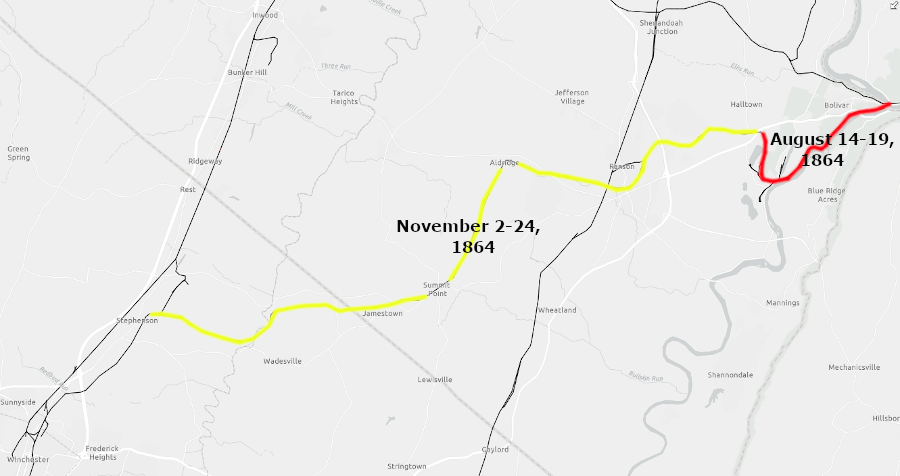
the US Military Railroads rebuilt the Winchester and Potomac Railroad in two phases, in August and November 1864
Source: ESRI, ArcGIS Online
Starting in 1867, the Baltimore and Ohio Railroad leased the Winchester and Potomac Railroad. Stockholders were guaranteed a 4% dividend. The B&O was guaranteed the ability to control all traffic on the line, and to block any competing railroads from connecting to it.
The B&O also financed the Winchester and Strasburg Railroad, which extended track 19 miles "up" the Shenandoah Valley from Wichester to the old Manassas Gap Railroad. In 1870, the B&O formally leased the Winchester and Strasburg Railroad. Winchester was no longer the southermost endpoint on a railroad linking much of the Sheandoah Valley to an Atlantic port city.
In 1873, the B&O acquired the rights to use Virginia Midland track (the old Manassas Gap Railroad) between Strasburg and Harrisonburg. However, Harrisonburg was not the objective; there was not sufficient traffic generated within the Shenandoah Valley to justify construction of the railroad west of Massanutten Mountain.
The Baltimore and Ohio Railroad intended for the Valley Railroad to build south to Tennessee, where it would connect with other railroads and draw traffic from the Deep South to Baltimore. The Valley Railroad reached Staunton in 1874, and headed south to Lexington and points beyond. The Baltimore and Ohio Railroad track through Virginia, including the Winchester and Potomac Railroad, was intended to become a bridge line. The plan was to create a mainline railroad bringing cotton and other products to northern factories, and shipping finished goods south to customers far beyond Virginia.
In 1899, the B&O took direct control by purchasing the Winchester and Potomac Railroad.1
Frederic Morton, The Story of Winchester in Virginia: The Oldest Town in the Shenandoah Valley, Heritage Books, 2009, pp.128-131, ; "Baltimore & Ohio timeline," Classic Trains, April 28, 2003, https://ctr.trains.com/railroad-reference/timelines/2003/04/baltimore-and-ohio-timeline; J. Randolph Kean, "The Development of the 'Valley Line' of the Baltimore and Ohio Railroad," The Virginia Magazine of History and Biography, Volume 60, Number 4 (October, 1952), pp.544-545, https://www.jstor.org/stable/4245875 (last checked April 4, 2020)
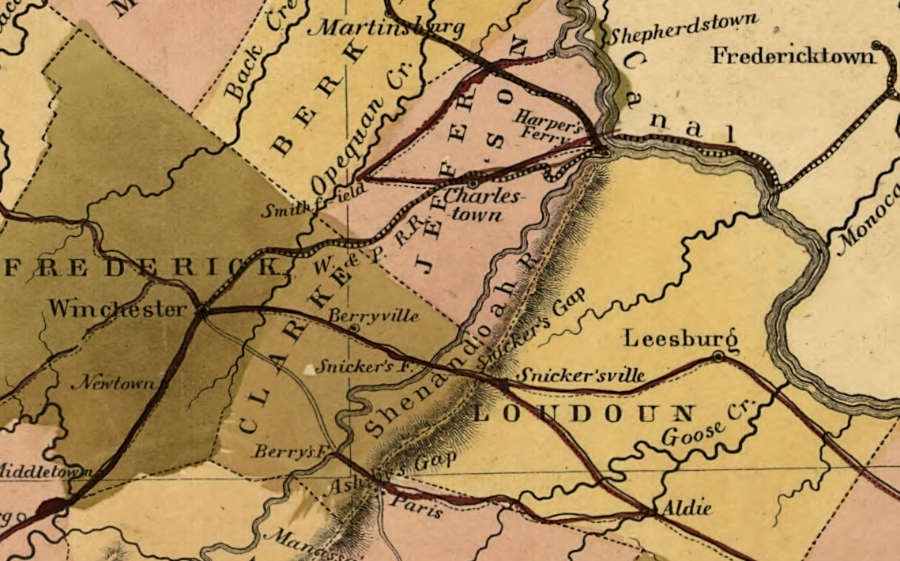
the first railroad into the Shenandoah Valley relied upon the Potomac River water gap at Harpers Ferry to cross the Blue Ridge
Source: Library of Congress, A map of the internal improvements of Virginia (Claudius Crozet, 1848)
The Shenandoah Pulp Mill and other mills on Virginius Island generated industrial traffic for the Winchester and Potomac. The northern depot was located on Virginius Island for the first decade, until space became available in Harpers Ferry.2
Mary Johnson, "A Nineteenth-Century Mill Village: Virginius Island, 1800-60," West Virginia History, Volume 54 (1995), http://www.wvculture.org/history/journal_wvh/wvh54-1.html (last checked November 30, 2018)
Alexandria merchants were not happy to see the business diverted away from the canal to Baltimore. Virginia officials did not want to assist growth of a port in Maryland, so the charter of the Winchester and Potomac Railroad prohibited any extension further south.
In the Civil War, the Winchester and Potomac Railroad played a unique role for supplying locomotives to Virginia/Confederate forces. In May, 1861, Col. Thomas Jackson (not yet known as "Stonewall") required the Baltimore and Ohio Railroad to schedule its train traffic in the middle of the day, supposedly to avoid disturbing the Virginia troops that were near Harpers Ferry.
According to local lore, one day Jackson stopped all traffic and seized locomotives and rail cars. Some were transported south across the Winchester and Potomac Railroad. At Winchester, they were hauled by oxen and mules along the Valley Turnpike to Strasburg, where the equipment was loaded on the track of the Manassas Gap Railroad.3 "Stories about The Great Train Raid of 1861," Fold3 by Ancestry, https://www.fold3.com/page/642820122-the-great-train-raid-of-1861/; Edward B. Burns, "The Confederates Gather Steam," The Railway and Locomotive Historical Society Bulletin, Nunmber 104 (April 1961), https://www.jstor.org/stable/43517986 (last checked April 4, 2020)
The Baltimore and Ohio formally acquired the Winchester and Potomac Railroad in 1902.
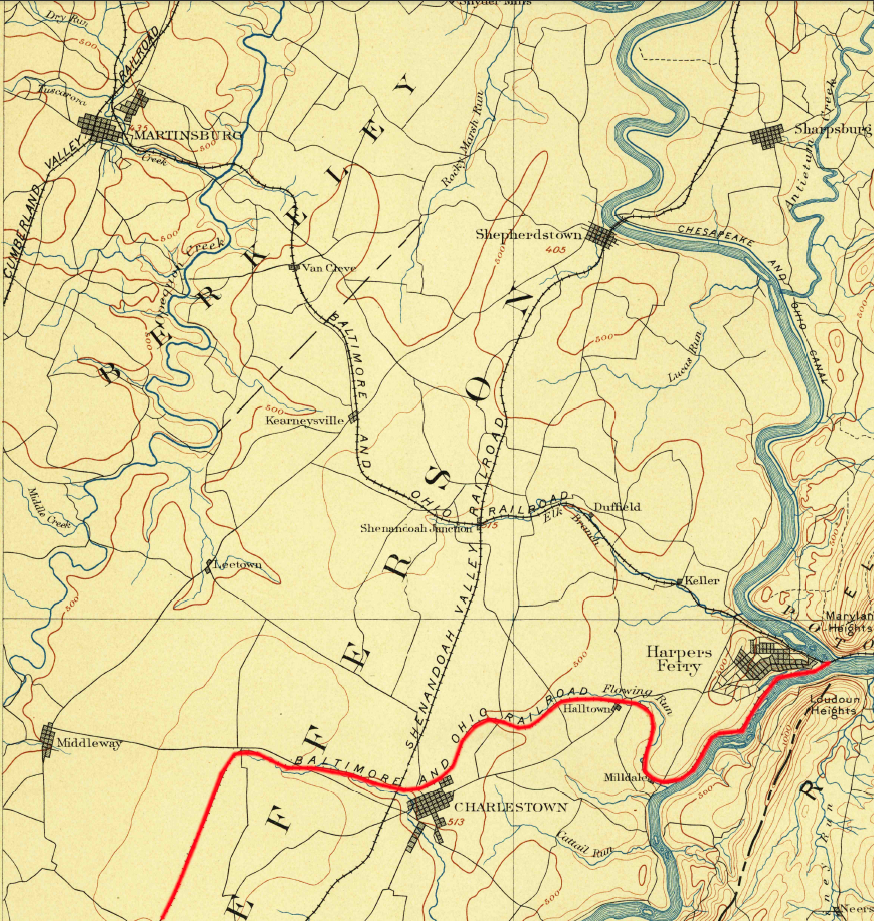
by 1893, the Winchester and Potomac Railroad red line) was just one of multiple railroads in the northern end of the Shenandoah Valley
Source: US Geological Survey (USGS), Harpers Ferry VA 1:125,000 topographic quadrangle (1893)
The track of the Winchester and Potomac Railroad became part of the CSX, after the merger between the Chesapeake & Ohio and the Baltimore and Ohio railroads.
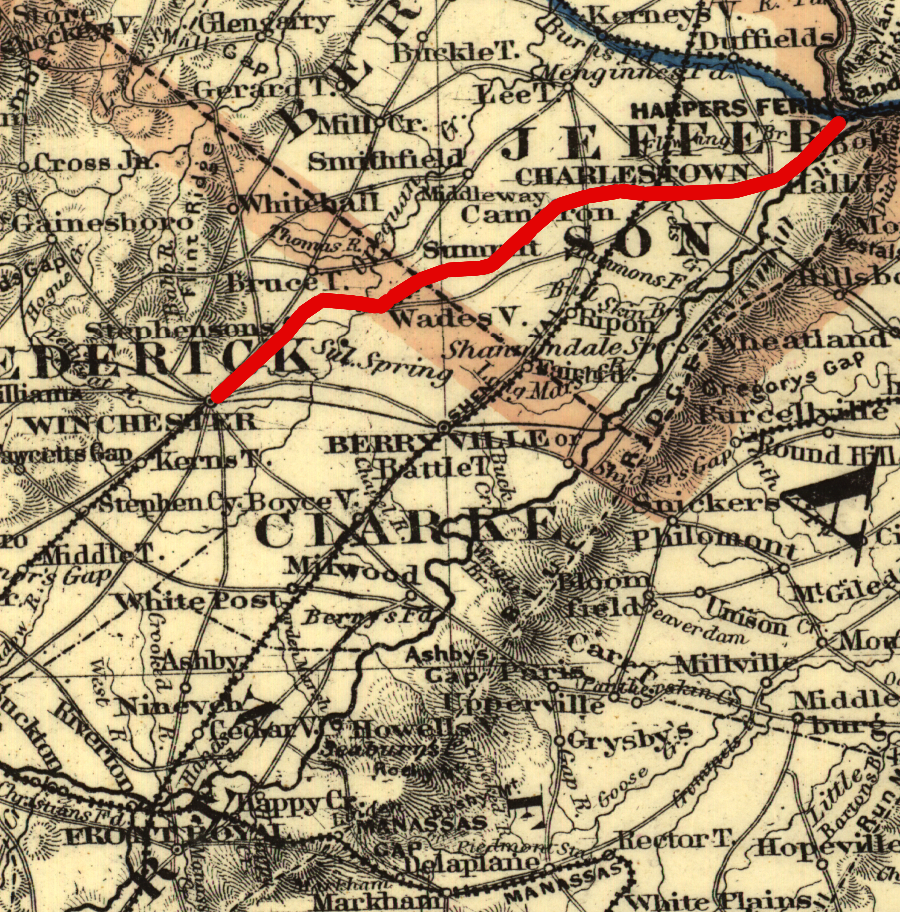
the Winchester and Potomac Railroad was constructed as a feeder line to the Baltimore and Ohio (B&O) Railroad
Source: Library of Congress, Map showing the West Virginia Midland Railway and its connections. (G.W. & C.B. Colton & Co., 1883)